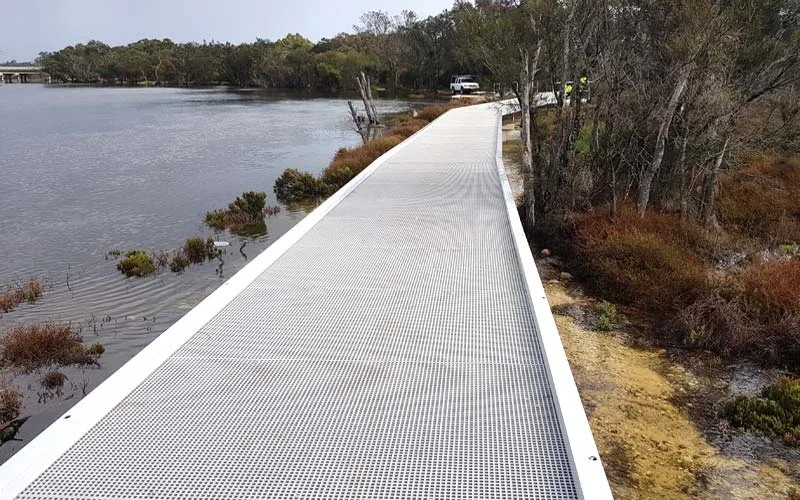Choosing the right decking material is essential, whether you’re overseeing an industrial facility, commercial project, or home improvement. Recently, fiberglass grate decking has surged in popularity as an innovative alternative to traditional materials like wood, steel, or aluminum. But is fiberglass really superior? Let’s explore the advantages and disadvantages clearly to help you make an informed decision.

fiberglass grate decking
Understanding Fiberglass Grate Decking
What is Fiberglass Grate Decking?
Fiberglass grate decking, also known as FRP (fiberglass reinforced plastic) grating, is made by combining fiberglass strands with a durable resin. This composite structure results in lightweight yet exceptionally strong decking suitable for various demanding applications, from marine environments to industrial facilities.
Common Uses and Applications
Industrial walkways and platforms
Marine docks and decks
Chemical processing plants
Commercial facilities and public parks
Residential pool decks and patios
According to industry data, fiberglass decking is rapidly becoming the standard in harsh environments due to its corrosion resistance and low maintenance.
Traditional Decking Materials Overview
Wood Decking
Traditionally favored for its aesthetic and affordability, wood decking remains common, especially in residential applications. However, wood is vulnerable to rot, mold, pests, and requires extensive maintenance, including regular sealing or staining.
Steel Decking
Steel decking offers excellent strength and durability, often used in industrial and commercial settings. Its main drawback is susceptibility to rust and corrosion, particularly in humid or marine environments, requiring protective coatings.
Aluminum Decking
Aluminum is lightweight, corrosion-resistant, and relatively maintenance-free. However, it can be costly upfront and less resistant to heavy impacts compared to steel or fiberglass options.
Comparing Fiberglass Grate Decking with Traditional Materials
Durability and Strength
Fiberglass Grate Decking: Exceptionally durable, corrosion-resistant, suitable for harsh environmental conditions.
Traditional Materials: Wood deteriorates quickly, steel requires protective coatings, and aluminum, although corrosion-resistant, can be dented or damaged by heavy loads.
Cost-Effectiveness
Fiberglass Grate Decking: Higher initial cost but significantly lower lifetime expenses due to minimal maintenance requirements.
Traditional Materials: Wood is cheaper initially but costly over time. Steel and aluminum have higher lifetime costs due to maintenance and replacement issues.
Maintenance Requirements
Fiberglass Grate Decking: Minimal maintenance, easily cleaned with water and mild detergent.
Traditional Materials: Require regular painting, sealing, sanding, or rust prevention treatments.
Safety and Slip Resistance
Fiberglass Grate Decking: Excellent slip resistance due to gridded texture; suitable for wet conditions, enhancing safety significantly.
Traditional Materials: Wood and steel decking often require additional anti-slip coatings; aluminum decks may become slippery when wet.
Environmental Impact
Fiberglass Grate Decking: Environmentally friendly due to longevity, low chemical treatments, and recyclability.
Traditional Materials: Wood harvesting impacts forests, steel and aluminum production involves significant energy consumption and carbon emissions.
Pros and Cons Summary Table
| Factor | Fiberglass Grate Decking ✅ | Wood ❌ | Steel ❌ | Aluminum ⚠️ |
|---|---|---|---|---|
| Durability | Excellent | Poor | Moderate | Good |
| Maintenance | Low | High | High | Moderate |
| Cost-effectiveness | Excellent (long-term) | Poor | Moderate | Moderate |
| Safety | Excellent | Moderate | Moderate | Good |
| Environmental Impact | Good | Poor | Moderate | Moderate |
Conclusion
Fiberglass grate decking stands out clearly when compared to traditional materials, thanks to its impressive durability, low maintenance requirements, superior safety features, and positive environmental impact. Although it involves a higher initial investment, the long-term savings and performance benefits justify the cost for most users.
When deciding which decking material to choose, consider your specific project requirements, environmental conditions, and long-term expectations. Fiberglass grate decking could indeed be the better option, particularly for environments where safety, durability, and low maintenance are priorities.
Ready to Choose Your Decking Material?
We’d love to hear your thoughts or experiences. Share your questions and feedback below, or contact us directly for personalized recommendations to suit your decking needs!




























